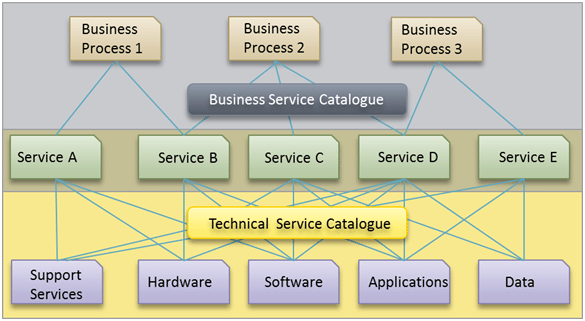 Branimir Valentic
Branimir Valentic
March 19, 2013
There is seldom such a controversial topic in IT Service Management as Service Catalogue. Though used by many organizations, it is often seen with different eyes. What is it, what should it contain, how should it be set up, who is it intended to serve… these are just some of the issues – important ones due to the fact that the Service Catalogue is an organization’s marketing and communication tool toward customers (existing customers, as well as potential ones). ITIL recognizes the importance of Service Catalogue and there are two processes inside the ITIL Service Lifecycle that provide a more detailed approach: Service Portfolio Management (as part of Service Strategy) and Service Catalogue Management (as part of Service Design).
Service Catalogue is, in its simpler form, a document. Such a document should contain services that are operational (i.e. alive) or services that are available for deployment. Seen from a business perspective, these are services that recover costs or earn profit, something that a customer can purchase. Therefore, it is important to communicate with the business and integrate them in strategic decisions, service development and design. These services will end up in the Service Catalogue, anyway.
Early involvement of the business side (e.g. sales and marketing people) shrinks possibilities for misdirection during the service strategy or service design phase. In real-world situations, a business knows its market, competition and customers, so they can provide valuable information during service development and they speak the business language.
Practically, there are two kinds of Service Catalogue for a Service:
Business Service Catalogue. If we are considering (potential) customers and what we offer (our Service Catalogue), then we are talking about Business Service Catalogue. Services that we offer are written in clear, easily understandable (as much as it is possible) or, as we like to say, business language. Usually, that is hard job to do as well as a reason why it is hard to establish a Service Catalogue for an organization. Sometimes I find that people involved in the development of a Service Catalogue are too technical, and the result is that the Service Catalogue is written too technical; but, if they do not have technical knowledge, it is hard to understand a detailed description of a service (which is a prerequisite to make a short and understandable summary).
Technical Service Catalogue. On the other side, Services have a lot of technology in their backgrounds. A technological solution has to be documented and explained in detail: that is the Technical Service Catalogue. It is written in technical language and is not intended to be published outside of the IT organization, i.e. customers don’t need to have access to such a document. Its value is in defining end-to-end service from a technical point of view.
 Figure: Correlation between Services and Business/Technical Service Catalogue
Figure: Correlation between Services and Business/Technical Service Catalogue
What usually happens is that organizations have a Business Service Catalogue, but rarely have a Technical Service Catalogue. Typically, the Technical Service Catalogue is usually presented via the functional specification of a service. If there is no other possibility, that is okay, but the Technical Service Catalogue should also contain information from other processes of a service lifecycle (e.g. Service Level Agreement data from Service Level Management process).
Typical content of a Business Service Catalogue includes deliverable description (services that we are offering, written in business language), service level parameters, costs, maintenance description, information about related services, description of the value that is provided to the customer, etc.
There are many reasons why a Service Catalogue is important, but I will mention just a few of them:
ITIL ensures that the Service Catalogue is produced, up to date, and contains reliable information. It also takes care that service details are provided (e.g. Service Name, Service Description, Availability, Service Owner/Representative etc.), current status is maintained and the services’ interdependencies are described. Utilization of the Service Catalogue depends on the organization itself. Therefore, template(s) for a particular organization can be developed, but data will be filled in depending on the services, targeted customer, market, competition, and other criteria.
Delivery of professional services is a goal of everyone competing in the market. A Service Catalogue is an excellent step forward in that direction, from both perspectives, inside the organization as well as outside the organization (the customers). Therefore, establishment of a Service Catalogue should be seen as an excellent opportunity to professionalize your own organization and to open the windows so that customers can start shopping.
To get a deeper understanding of the Service Catalogue, you can download a free preview template.